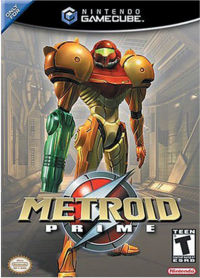Metroid Prime

| |
| Metroid Prime | |
| Full Title | Metroid Prime |
| Developer | Retro Studios |
| Publisher | Nintendo |
| System | Gamecube, Wii, Switch |
| Release Date | Gamecube US November 15, 2002 JP February 28, 2003 EU March 21, 2003 Wii JP February 19, 2009 Switch February 8, 2023 (digital) US February 23, 2023 EU/JP March 3, 2023 |
| Genre | Action/First Person Shooter |
| Gallery | GH Gallery |
| Rating | ESRB: Teen |
Metroid Prime is a 3D first-person action game that was released for the Nintendo Gamecube in 2002 (in the United States) and 2003 (in other regions). The first 3D Metroid game, this game was developed by the American development studio Retro Studios as their debut game and launched its own subseries within the Metroid franchise. This game combines elements of a first-person shooter with the action, exploration and platforming elements of the traditional Metroid games.
Story[edit]
The story is set between Metroid and Metroid II: The Return of Samus. A distress signal leads Samus to pursue Space Pirates onto the planet Tallon IV. Along the way, she spots her enemy Ridley, who has now been augmented into Meta Ridey. Samus begins exploring the planet in order to shut down its Space Pirate operation. Her journey leads her to explore the planet's Chozo ruins and to deal with a mysterious, deadly substance known as Phazon.
Gameplay[edit]
This game reinvents the Metroid formula in 3D, retaining the feeling of an open setting while translating Samus's abilities into three dimensions. The game is divided into six different areas connected by elevators, which are unlocked as the player progresses through the game and unlocks new abilities.
The first person style gameplay lends itself to several innovations. The player is able to lock-on to targets, similar to the Z-Lock system introduced in The Legend of Zelda: Ocarina of Time. Players can also use different visors to see differently. For example, the infrared visor is helpful when battling enemies that blend into their surroundings. There is also the scan visor, which can be used to identify enemies and log entries that are saved to Samus's Logbook.
If the player has a Game Boy Advance and a copy of Metroid Fusion, players can connect the two games. Connecting them can unlock the original Metroid as well as the Fusion suit if the player has beaten one of the games.
Continuity Notes[edit]
- The game chronologically acts as a follow-up to the original Metroid. The entire Prime subseries is set between the original two Metroid games. This game references the events of Metroid, with the Space Pirates' logs retelling the game's story from their point of view. The game also explains Ridley's survival following the events of Metroid.
- This game also notably follows the fate of the Chozo, which was not addressed in past games, although Metroid Dread would later establish a different fate for the Chozo involved in Samus's life. Within Metroid Prime, the Chozo Lore entries allude to their time raising Samus, which would be the first time this was directly mentioned within the games. However some continuity references such as this were changed in the PAL version.
Legacy[edit]
Metroid Prime spawned its own subseries which had several spin-offs and sequels which are mentioned below. This subseries seemed to end in 2007 with the end of the main Prime trilogy, as Nintendo then reclaimed control of the franchise while Retro went on to work on other Nintendo properties, until Metroid Prime 4 was announced a decade later.
Sequels[edit]
Metroid Prime was directly followed by Metroid Prime 2: Echoes, and the trilogy ended on the Nintendo Wii with Metroid Prime 3: Corruption. It has also led to two spin-offs, Metroid Prime Hunters and Metroid Prime Pinball. Hunters chronologically takes place between the first two Metroid Prime games, while Pinball retells the story of Metroid Prime through a pinball interface (with the unique Metroid conceit of Samus being trapped in Morph Ball form for the majority of the game).
Ports and Remakes[edit]
- A special version of Metroid Prime was bundled with the platinum Gamecube to promote Metroid Prime 2. It included a second disc with a Metroid timeline, an art gallery, and a trailer and demo for Metroid Prime 2.
- In Japan, the game was rereleased with new Wii controls as part of the New Play Control series. Instead of that release, the Wii in North America and Europe received a bundle of all three Metroid Prime games known as Metroid Prime Trilogy.
- A remastered high-definition version of Metroid Prime was announced and released for the Nintendo Switch in February 2023 with the simple title of Metroid Prime Remastered. Aside from the updated visuals, this release featured multiple control options and unlockable art. Retro Studios worked on this remaster in collaboration with Iron Galaxy Studios.
| Titles in the Metroid Series |
|---|
| Metroid (Zero Mission) - Return of Samus (3DS) - Super Metroid - Other M - Fusion Metroid Prime - Pinball - Echoes - Hunters - Corruption - Federation Force - 4 Metroid Dread |